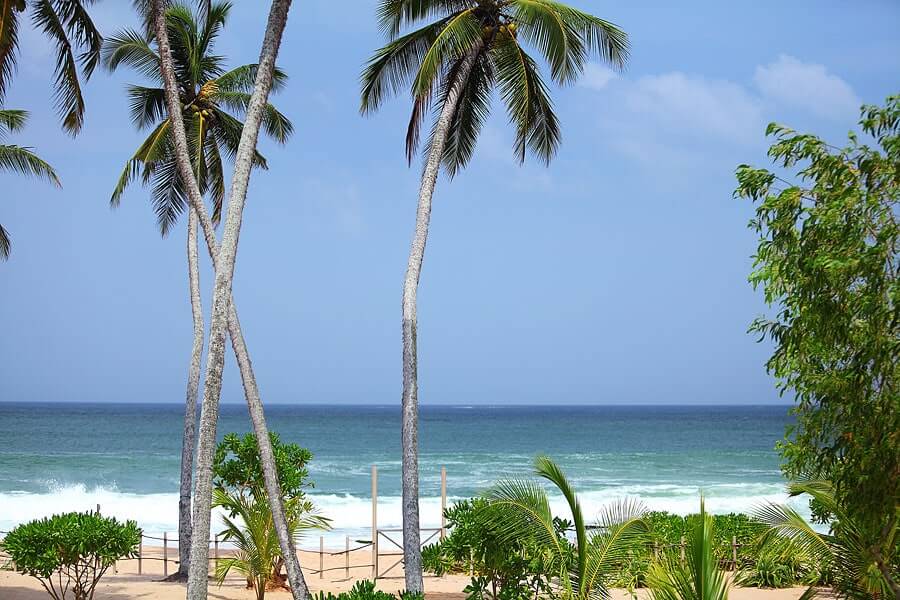What is the weather like in Sri Lanka? Is it possible to travel to Sri Lanka in the summer? When is the rainy season? And what far-reaching effects did the British colonizers have on the weather? I’ll address these and other questions about the vagaries of Sri Lankan weather in today’s blog.
Temperatures in the 30s, below zero only in the freezer
Right off the bat, the good news is that you can go to Sri Lanka anytime. Really. If Madeira is known as the “island of eternal spring”, Sri Lanka could easily be called the “island of eternal summer”. Thanks to its location just below the equator, the weather is very warm all year round. The average temperature is 28 – 30 °C, in the hottest months 35 – 38 °C, and the ocean temperature is consistently around 28 °C. If you spend your holidays in Sri Lanka in coastal areas or sightseeing, you can easily get by with flip-flops and summer clothes. You can expect lower temperatures only in mountainous areas. But even here, the cold is not dramatic. Most locals only know frost and snow from movies and stories. So if you’re planning to climb the sacred Adam’s Peak, pack your sneakers and a windbreaker, but otherwise, you don’t have to worry about winter in Sri Lanka.
When is the rainy season in Sri Lanka?
What you should consider when planning your holiday is the rainy season. In general, the weather is influenced by two main monsoon seasons: the southwest monsoon (May to September) and the northeast monsoon (December to February). However, beware. Contrary to popular belief and the information given in almost every guidebook, most of the rainfall does not come during the monsoon season, but, during the so-called “intermonsoon”, the highest rainfall ever falls on the island between October and early November.
How is that possible? According to climatologist and tropical specialist Lareef Zubair, the term “monsoon” is very misunderstood in relation to Sri Lanka. Have you read the book “When the rains came”? In it, the author describes monsoons in India as several weeks of incessant cloudbursts accompanied by floods. And this is exactly the image of the monsoon that I, and apparently the authors of Lonely Planet and other guidebooks, have carried in my head for a long time. But I was wrong. As Lareef explains, the word “monsoon” comes from the Arabic “mawsim”, which simply refers to a season defined by the prevailing wind direction.
Bloody British!
The identification of the word “monsoon” with heavy, prolonged rains, according to Lareef, is due to British colonisers who associated it exclusively with the heavy rains that the monsoon season brings to most of India, just as in the book mentioned above. But that is not the case with Sri Lanka! “Bloody British!”, our friend Chaminda who can´t stand the inhabitants of the UK because of their colonial past would curse at this point. And he would add to the list of wrongs they have done to Sri Lanka the utter confusion about when it rains the most on the island.
And it is not only tourists who are confused in this case. According to Lareef, the misdescribed rhythm of the weather goes not only across guidebooks but also in literature and films. An unintended and actually quite humorous consequence is, for example, the scheduling of international matches in cricket, the most popular and watched sport among Sri Lankans. In an effort to avoid monsoon rains, they are often scheduled in the intermonsoon months and thus, as we already know, paradoxically, in the period when it rains most of the year. Players are thus condemned to slipping through the mud and frequent interruptions of matches, and the spectator is left wondering.
Common sense
What the British messed up did not confuse the local peasants. Farmers know the changing weather well, and so the traditional farming seasons are Maha (October to March) and Yala (April to September), each beginning with a period of heavy rainfall and ending with dry weather for the harvest. And this is exactly what our experience corresponds to. In our twenty years in Sri Lanka, we have seen that in the south, the heavier rains do indeed come in early May, but they last no longer than the end of June, followed by a dry season again, with isolated showers at most. The sea can be wilder due to the wind. This continues until about the end of September, when the main rainy season begins, again lasting 5-6 weeks, i.e. until the end of October/beginning of November.
Despite the monsoons, the intermonsoons, and the British
What does all this mean for travellers? Firstly, contrary to popular belief, you can safely head down to the south during the summer months. Compared to the east coast, the sea may be much wilder this time of year, but you don’t have to worry about persistent rain. This will be especially appreciated by parents of school children or people working in education or other jobs where holidays are tied to the summer holidays. And secondly, even at the height of the raining season, it is not so bad with the rains.
I’ll add a personal experience where I’ve made two consecutive trips to Tangalle with my family in recent years, from late October to mid-December – the time when the peak of the rain and then gradually recedes. On both occasions, we experienced heavy, persistent rain lasting several hours about two or three times during our stay. In the first few days after our arrival, i.e. late October and early November, it usually rained in varying intensity during the day or night (either a short, heavy downpour that was gone in a few minutes or a light shower that lasted for maybe two or three hours). The sky was more often cloudy, but almost always the sun peeked out at least for a while, and there were no exceptions to the completely sunny days, which gradually increased. Swimming is possible because, as already mentioned, it is always warm. And I, on the other hand, liked the fact that I didn’t have to run after the kids with sunscreen hundreds of times a day and that it was more pleasant temperature for various trips. The sea can be cloudy from the sand after the rain. But this is on the other hand compensated by the fact that this time of year you will have even the most “profligate” beaches, like the increasingly popular Hiriketiya, only for yourself.
So if you don’t need continuous azure weather for a perfect holiday and instead appreciate slightly cooler temperatures than the rest of the year, don’t be afraid to head south not only in summer but also from the end of October onwards. There are other benefits too, generally fewer tourists come at this time and you’ll pay less for accommodation thanks to off-season discounts. So, going back in an arc to what I wrote at the beginning – you can go to Sri Lanka at any time and to pretty much any part of it. Although the patterns described above generally apply, you can get rain in the middle of the dry season. So put your weather worries behind you and just go to Sri Lanka when it suits you. Monsoons, inter-monsoons, and Brits notwithstanding.
Resources: https://groundviews.org/2012/11/08/monsoons-and-intermonsoons/


